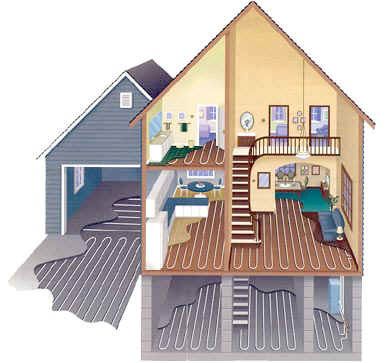
One of the benefits of combining a radiant-floor heat distribution system with a concrete slab is consistent indoor temperatures. The high mass of the concrete is relatively slow to change in temperature, so the house shouldn’t experience the constant variations in temperatures that sometimes go along with a forced-air heating system.
Getting the concrete to the right temperature takes time, and that raises a question about the best strategy at night: Should the thermostat be kicked down to save a little energy while everyone is sleeping, or does that just mean the heating system has to work extra hard in the morning to get the house back to a comfortable level?
That’s question is at the heart of this Q&A post at GreenBuildingAdvisor.
David Meiland thinks there’s a benefit to a nighttime setback. His heating contractor does not. The conversation draws in others who also have had trouble fine-tuning their radiant-floor systems, and it’s the subject of this month’s Q&A Spotlight.
Read the whole article at Green Building Advisor.
Fine Homebuilding Recommended Products
Fine Homebuilding receives a commission for items purchased through links on this site, including Amazon Associates and other affiliate advertising programs.

Reliable Crimp Connectors

8067 All-Weather Flashing Tape

Affordable IR Camera

Living with radiant-floor heatFrom an energy and comfort standpoint, does it make any sense to turn down the thermostat at night when you have a radiant-floor heating system?



























View Comments
I have designed radiant heating systems for many years and I have radiant heat in my home. I set the thermostat on 70 degrees,in the winter, and do not more it ever. Once you have heated the mass it does not take much energy to maintain temperature. If you move the thermostat, say to 60 or 65 degrees at night, it will take more energy to bring the mass back to 70 degrees. Once you set the temperature leave it alone.
When I designed my addition (dining room, office, laundry and rec room) I poured concrete floors for radiant heat.
I had experienced homes with radiant heat that resulted in varying degrees of discomfort to the stocking feet. In order to have my cake and eat it to I constructed a hybrid system utilizing a hot water heated baseboard panel that looks like colonial baseboard as it's only an inch thick. It's made from extruded aluminum, along with the radiant heat.
I have the water going through the baseboard at 140-180 degrees F while the radiant floor temperature never goes above 80 degrees F The floor thermostat is set to start heating the floor at 69 and the override runs the floor up to 75 (higher if it's very cold and the baseboard maxes out) but never higher than 80. I have mixing valves on the various zones that limit the water to the floor loops to 105 F. I have a program on the baseboard thermostat but the floor is set to be running only if the room temp is 69 or less. In cold weather the room temp will generally drop enough by early morning- 0500 or so to call for the floor to heat. The baseboard is set to kick in at 0700, earlier if the temp drops down to 62 F or less, and goes to 71 F- our living area desired temp.
The floor is never uncomfortable and the temperature in the house is very even floor to ceiling.
Sure it's more expensive to install but I figure I'm only getting one trip through and want to be comfortable as possible.
John
Most of our customers will set the t-stat at one temp and leave it. This is a good practice for those systems that have high thermal mass. For low thermal mass systems then you can see some benefit from setting them back at times. One example of a low thermal mass system is the pre-fab plywood products with aluminum on top. These systems respond quite quickly to new inputs of energy.
I always compare running a radiant system to the gas mileage you get with your car. You get the worst mileage in the city when you are constantly starting and stopping but better mileage on the highway when you're cruising at a steady temperature. In many cases, this is the same with a radiant heating system. Have questions? You can contact us here: http://www.radiantec.com
That should say, "cruising at a steady speed," not temperature! :) (post below)
We have had radiant floor heat for two years now (new house) and do not change the T-stat. I can not imagine getting up in the morning ( or middle of the night) to cold floors; I've gotten spoiled. I suppose you could set things to have the heat come on before you get up, but then there are the odd days, nights, etc. I don't think you can gain much from set-back, as the lag time is so long on each end.One note: If you have a super-insulated house, tile will still feel cool most of the time, but never cold. You can't have the floor more than a couple of degrees over your target air temp, or you will cook. So, plan on cool concrete/tile floors.